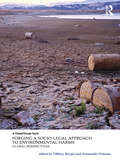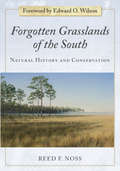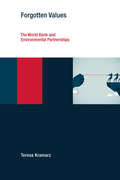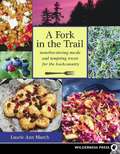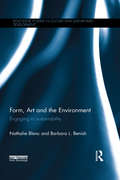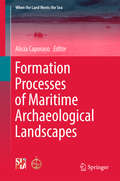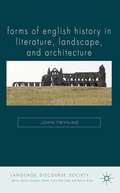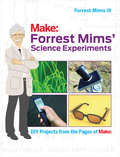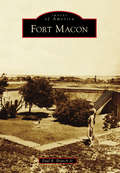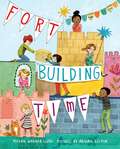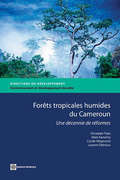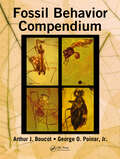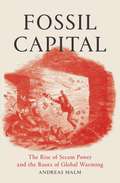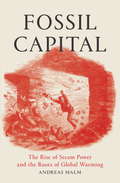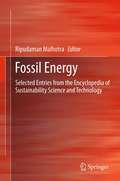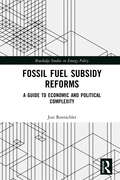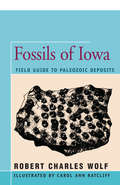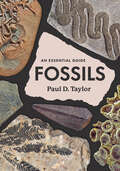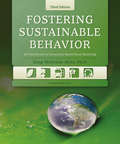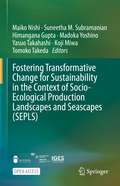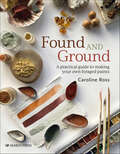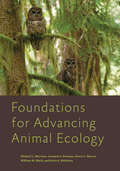- Table View
- List View
Forging a Socio-Legal Approach to Environmental Harms: Global Perspectives (Law, Justice and Ecology)
by Tiffany Bergin Emanuela OrlandoEnvironmental harms exert a significant toll and pose substantial economic costs on societies around the world. Although such harms have been studied from both legal and social science perspectives, these disciplinary-specific approaches are not, on their own, fully able to address the complexity of these environmental challenges. Many legal approaches, for example, are limited by their inattention to the motivations behind environmental offences, whereas many social science approaches are hindered by an insufficient grounding in current legislative frameworks. This edited collection constitutes a pioneering attempt to overcome these limitations by uniting legal and social science perspectives. Together, the book’s contributors forge an innovative socio-legal approach to more effectively respond to, and to prevent, environmental harms around the world. Integrating theoretical and empirical work, the book presents carefully selected illustrations of how legal and social science scholarship can be brought together to improve policies. The various chapters examine how a socio-legal approach can ultimately lead to a more comprehensive understanding of environmental harms, as well as to innovative and effective responses to such environmental offences.
Forgotten Grasslands of the South: Natural History and Conservation
by Reed F NossForgotten Grasslands of the South is the study of one of the biologically richest and most endangered ecosystems in North America. In a seamless blend of science and personal observation, renowned ecologist Reed Noss explains the natural history of southern grasslands, their origin and history, and the physical determinants of grassland distribution, including ecology, soils, landform, and hydrology. In addition to offering fascinating new information about these little-studied ecosystems, Noss demonstrates how natural history is central to the practice of conservation. Although theory and experimentation have recently dominated the field of ecology, ecologists are coming to realize how these distinct approaches are not divergent but complementary, and that pursuing them together can bring greater knowledge and understanding of how the natural world works and how we can best conserve it. This long-awaited work sets a new standard for scientific literature and is essential reading for those who study and work to conserve the grasslands of the South as well as for everyone who is fascinated by the natural world.
Forgotten Values: The World Bank and Environmental Partnerships (Earth System Governance)
by Teresa KramarzAn examination of the conflict between values and bureaucracy in World Bank biodiversity partnerships that sheds light on this model of global environmental governance.Multi-stakeholder partnerships have become an increasingly common form of global governance. Partnerships, usually between international organizations (IOs) or state agencies and such private actors as NGOs, businesses, and academic institutions, have even been promoted as the gold standard of good governance--participatory, innovative, and well-funded. And yet these partnerships often fail to live up to the values that motivated their establishment. In this book, Teresa Kramarz examines this gap between promise and performance by analyzing partnerships in biodiversity conservation initiatives launched by the World Bank.
Fork in the Trail
by Laurie Ann MarchInspired by foods from all over the world and the guiding principle of "if you wouldn't eat it at home, why eat it in the backcountry," Laurie Ann March has created over 200 lightweight, taste-tested recipes to turn an ordinary backcountry outing into a gourmet adventure. In addition to the recipes, March covers menu planning, recipe creation, and meal planning for families and larger groups. Color photograph insert.
Form, Art and the Environment: Engaging in Sustainability (Routledge Studies in Culture and Sustainable Development)
by Nathalie Blanc Barbara L. BenishForm, Art and the Environment: Engaging in Sustainability adopts a pluralistic perspective of environmental artistic processes in order to examine the contributions of the arts in promoting sustainable development and culture at a grassroots level and its potential as a catalyst for social change and awareness. This book investigates how community arts, environmental creativity, and the changing role of artists in the Polis contribute to the goal of a sustainable future from a number of interdisciplinary perspectives. From considering the role that art works play in revealing local environmental problems such as biodiversity, public transportation and energy issues, to examining the way in which artists and art works enrich our multidimensional understanding of culture and sustainable development, Form, Art and the Environment advocates the inestimable value of art as an expressive force in promoting sustainable culture and conscious development. Utilising a broad range of case studies and analysis from a body of work collected through the international environmental COAL prize, this book examines the evolution of the relationship between culture and the environment. This book will be of interest to practitioners of the environmental arts, culture and sustainable development and students of Art, Environmental Science, and International Policy and Planning Development.
Formal Peace and Informal War: Security and Development in Congo (Routledge Explorations in Development Studies)
by Zoë MarriageNorthern interventions into African countries at war are dominated by security concerns, bolstered by claims of shared returns and reinforcing processes of development and security. As global security and human security became prominent in development policy, Congo was wracked by violent rule, pillage, internal fighting, and invasion. In 2002, the Global and All-Inclusive Peace was promoted by northern donors, placing a formal peace on the mass of informalised wars. Formal Peace and Informal War: Security and Development in Congo examines how the security interests of the Congolese population have interacted with those of northern donors. It explores Congo’s contemporary wars and the peace agreed on in 2002 from a security perspective and challenges the asserted commonality of the liberal interventions made by northern donors. It finds that the peace framed the multiple conflicts in Congo as a civil war and engineered a power-sharing agreement between elite belligerents. The book argues that the population were politically and economically excluded from the peace and have been subjected to control and containment when their security rests with power and freedom.
Formation Processes of Maritime Archaeological Landscapes
by Alicia CaporasoResearch into the anthropogenic and taphonomic processes that affect the formation of maritime archaeological resources has grown significantly over the last decade in both theory and the analysis of specific sites and associated material culture. The addition of interdisciplinary inquiry, investigative techniques, and analytical modeling, from fields such as engineering, oceanography, and marine biology have increased our ability to trace the unique pathways through which archaeological sites progress from initial deposition to the present, yet can also link individual sites into an integrated socio-environmental maritime landscape. This edited volume presents a global perspective of current research in maritime archaeological landscape formation processes. In addition to "classically" considered submerged material culture and geography, or those that can be accessed by traditional underwater methodology, case studies include less-often considered sites and landscapes. These landscapes, for example, require archaeologists to use geophysical marine survey equipment to characterize extensive areas of the seafloor or go above the surface to access maritime archaeological resources that have received less scholarly attention.
Forms of English History in Literature, Landscape, and Architecture
by John TwyningAn exploration of the way English literature has interacted with architectural edifices and the development of landscape as a national style from the Middle Ages to the 19th Century. Analyzing texts in relation to cultural artefacts, each chapter demonstrates the self-conscious production of English consciousness as its most enduring history.
Forrest Mims' Science Experiments: DIY Projects from the Pages of Make:
by Forrest M. Mims IIIForrest M. Mims is a revered contributor to Make: magazine, where his popular columns about science-related topics and projects for Makers are evergreen treasures. Collected together here for the first time, these columns range from such simple projects as building an LED tracker for hand-launched night rockets to such challenging builds as transforming strings of data into unique musical compositions.A variety of photography and imaging projects are featured, including an ultra-sensitive twilight photometer that measures the elevation of layers of dust, smoke, and smog from around 3,000 feet to the top of the stratosphere at 31 miles! Most of the projects can be done with a collection of simple electronic components, such as LEDs, transistors, resistors, and batteries. To inspire and motivate readers, the book also includes profiles of such famous Makers as President Thomas Jefferson and Microsoft co-founder Paul Allen.
Fort Macon
by Paul R. BranchSilently standing guard on the eastern point of Bogue Banks overlooking the entrance to Beaufort Harbor, Fort Macon is the centerpiece of one of the most visited North Carolina State Parks. Since Fort Macon State Park was established in 1924, it has been a familiar destination for millions of visitors to the "Crystal Coast" of Carteret County, North Carolina. The old historic fort itself, standing today in venerable repose, harkens back to another time in our country's history, however. At different times throughout its long, storied past, the fort has served as a US Army garrison post, a stronghold occupied for defense in three different wars, the scene of a desperate battle, a prison, and finally the second oldest state park in North Carolina. Fort Macon showcases this unique coastal fortification through historic images, highlighting not only its military past, but its role as a popular tourism destination through the years.
Fort-Building Time
by Megan Wagner LloydGrab your blankets and pillows! From the creators of Finding Wild, a new picture book that follows the changing of the seasons and is as cozy as a fort. Winter, spring, summer, fall. Each season brings new materials to make the perfect fort. From leaves to snow, from mud to sand, there is a different fort throughout the year. As a group of friends explore and build through the seasons, they find that every fort they make is a perfect fort. From the team behind Finding Wild, which Publishers Weekly called &“a sparkling debut&” and a &“whimsical meditation on the idea of wildness,&” Megan Wagner Lloyd and Abigail Halpin are together again for a portrayal of a classic childhood endeavor that is perfect all year long.
Forêts Tropicales Humides du Cameroun
by Carole Megevand Giuseppe Topa Laurent Debroux Alain KarsentyEn 1994, le gouvernement camerounais a initié des réformes légales et commerciales visant à réguler les droits d'accès et d'usage des forêts tropicales, qui constituent une richesse incontestable pour le pays. Ces réformes cherchaient à équilibrer les intérêts publics et privés et à plus largement intégrer les perspectives économiques, culturelles et environnementales. Aujourd'hui, plus de 60 pourcent des forêts tropicales du Cameroun sont exploitées selon un plan d'aménagement agréé. L'exploitation illégale dans les forêts aménagées a significativement diminué, la biodiversité est protégée plus efficacement et l'industrie forestière, restructurée, adhère largement aux pratiques de gestion durable reconnues internationalement. Basé sur des données historiques, des recherches spécifiques et des travaux analytiques, 'Forêts tropicale humides du Cameroun : Une décennie de réformes' présente la genèse et le déploiement de ces réformes. Ce livre identifie les politiques qui ont porté leur fruit, celles qui n'ont pas fonctionné et propose des améliorations. Bien que ces réformes aient été élaborées et mises en oeuvre dans un contexte spécifique, les enseignements tirés de cette expérience pourront servir à d'autres pays, connaissant des réalités similaires. Ce livre devrait être notamment utiles aux analystes politiques et experts du développement, ainsi qu'aux gouvernements, aux populations et aux agences de développement des pays riches en forêts tropicales, en Afrique et ailleurs.
Fossil Behavior Compendium
by Arthur J. Boucot George O. Poinar Jr.In this complete and thorough update of Arthur Boucot's seminal work, Evolutionary Paleobiology of Behavior and Coevolution, Boucot is joined by George Poinar, who provides additional expertise and knowledge on protozoans and bacteria as applied to disease. Together, they make the Fossil Behavior Compendium wider in scope, covering all relevant ani
Fossil Capital: The Rise of Steam Power and the Roots of Global Warming
by Andreas MalmHow capitalism first promoted fossil fuels with the rise of steam power The more we know about the catastrophic implications of climate change, the more fossil fuels we burn. How did we end up in this mess?
Fossil Capital: The Rise of Steam Power and the Roots of Global Warming
by Andreas MalmHow capitalism first promoted fossil fuels with the rise of steam powerThe more we know about the catastrophic implications of climate change, the more fossil fuels we burn. How did we end up in this mess? In this masterful new history, Andreas Malm claims it all began in Britain with the rise of steam power. But why did manufacturers turn from traditional sources of power, notably water mills, to an engine fired by coal? Contrary to established views, steam offered neither cheaper nor more abundant energy--but rather superior control of subordinate labour. Animated by fossil fuels, capital could concentrate production at the most profitable sites and during the most convenient hours, as it continues to do today. Sweeping from nineteenth-century Manchester to the emissions explosion in China, from the original triumph of coal to the stalled shift to renewables, this study hones in on the burning heart of capital and demonstrates, in unprecedented depth, that turning down the heat will mean a radical overthrow of the current economic order.From the Trade Paperback edition.
Fossil Energy
by Ripudaman MalhotraThe word sustainability shares its root with sustenance. In the context of modern society, sustenance is inextricably linked to the use of energy. Fossil Energy provides an authoritative reference on all aspects of this key resource, which currently represents nearly 85% of global energy consumption. Gathering 16 peer-reviewed entries from the Encyclopedia of Sustainability Science and Technology, the chapters provide comprehensive, yet concise coverage of fundamentals and current areas of research. Written by recognized authorities in the field, this volume represents an essential resource for scientists and engineers working on the development of energy resources, fossil or alternative, and reflects the essential role of energy supplies in supporting a sustainable future.
Fossil Fuel Subsidy Reforms: A Guide to Economic and Political Complexity (Routledge Studies in Energy Policy)
by Jun RentschlerCountries around the world are spending up to $500 billion per year on subsidising fossil fuel consumption. By some estimates, the G20 countries alone are spending around another $450 billion on subsidising fossil fuel production. In addition, the indirect social welfare costs of these subsidies have been shown to be substantial – for instance due to air pollution, road congestion, climate change, and economic inefficiency, to name a few. Considering these numbers, there is no doubt that fossil fuel subsidies cause severe economic distortions that compromise countries’ prospects of achieving equitable and sustainable development. This book provides a guide to the complex challenge of designing, assessing, and implementing effective fossil fuel subsidy reforms. It shows that subsidy reform requires a careful balancing of complex economic and political trade-offs, as well as measures to mitigate adverse effects on vulnerable households and to assist firms with implementing efficiency enhancing measures. Going beyond the purely fiscal perspective, this book emphasises that smart subsidy reforms can contribute to all three dimensions of sustainable development – environment, society, and economy. Over the course of eight chapters, this book considers a wide range of agents and stakeholders, markets, and policy measures in order to distil the key principles of designing effective fossil fuel subsidy reforms. This book will be of great relevance to scholars and policy makers with an interest in energy economics and policy, climate change policy, and sustainable development more broadly.
Fossils Tell of Long Ago (Let's-Read-and-Find-Out Science 2)
by AlikiWhat is a fossil?Sometimes it's the imprint of an ancient leaf in a rock. Sometimes it's a woolly mammoth, frozen for thousands of years in the icy ground. Sometimes it's the skeleton of a stegosaurus that has turned to stone.A fossil is anything that has been preserved, one way or another, that tells about life on Earth. But you can make a fossil, too—something to be discovered a million years from now—and this book will tell you how.
Fossils of Iowa: Field Guide to Paleozoic Deposits
by Robert Wolf Carol Ann RatliffThe Fossils of Iowa field guide is written primarily for amateurs in geological exploration and collecting. Robert Wolf provides a comprehensive coverage of more than 150 sites in Iowa and adjacent areas of Minnesota and Nebraska with the types of fossils that can be found and precise directions. Excellent illustrations by Carol Ann Ratcliff aide in identification. For an update in site conditions and geological names since the book was first published contact the author at midnightwriter@frontiernet.net.
Fossils: An Essential Guide
by Paul D. TaylorWith stunning images and an expert guide, explore the world of fossils to uncover the story of life on Earth, from the origins of new life to mass extinctions. Ancient Earth seems like an alien world. But the fossil record can help reveal the mysteries of the organisms that have lived on our planet since its formation some 4,600 million years ago. In this engaging and beautifully illustrated book, world-renowned paleontologist Paul D. Taylor provides a comprehensive guide to all aspects of fossils to tell the story of life on Earth. Taylor begins with the basics: how fossils form, how they mark geological time, and what they tell us about the origins of life and major evolutionary events like the Cambrian Explosion. He then shows the oldest fossils—single-celled bacteria in amazing, three-billion-year-old microbial rock structures—before introducing the first animals in the fossil record. From fishes to amphibians, reptiles, and mammals, we meet these animal fossils in an appropriate evolutionary parade. Next, we imagine plants long past, charting the evolution of this kingdom and learning how ephemeral botanical remains can become permanent records. While comprehensive in his coverage of fossil groups and ages, Taylor pays particular attention to specimens fossil hunters are most likely to encounter, like crinoids and the iconic ammonites. Throughout, he introduces us to fascinating fossil folklore—like the idea that ammonites are the petrified remains of coiled snakes—and helps us distinguish true fossils from fakes. With stunning color images of many original specimens from the collections of London’s Natural History Museum, Fossils is an essential introduction, connecting life on Earth today to the ancient past.
Fossils: The Key to the Past
by Richard A. ForteyA guide for amateur fossil collectors and general readers to how fossils came about, how to find and identify them, and their economic and practical importance. Emphasizes fossils easy to find. Includes a short glossary without pronunciation.
Fostering Sustainable Behavior
by Doug Mckenzie-MohrTo attain a sustainable future, we must change many of our everyday actions. This completely revised and updated edition of Fostering Sustainable Behavior shows how community-based social marketing is key to overcoming barriers and resistance, and creating new social norms.
Fostering Transformative Change for Sustainability in the Context of Socio-Ecological Production Landscapes and Seascapes (SEPLS)
by Himangana Gupta Maiko Nishi Suneetha M. Subramanian Madoka Yoshino Yasuo Takahashi Koji Miwa Tomoko TakedaThis open access book is a compilation of case studies that provide useful knowledge and lessons that derive from on-the-ground activities and contribute to policy recommendations, focusing on the relevance of social-ecological production landscapes and seascapes (SEPLS) to “transformative change.” The concept of “transformative change” has been gaining more attention to deal with today’s environmental and development problems, whereas both policy and scientific communities have been increasingly calling for transformative change toward sustainable society. The Intergovernmental Science-Policy Platform on Biodiversity and Ecosystem Services (IPBES) has planned to start the so-called “assessment on transformative change” if approved by the IPBES plenary to be held in 2021. At present, the idea of transformative change, including its scope, methodologies, approaches and strategies, are yet to be clarified. By bringing together all of the different concerns and interests in the land/seascape, SEPLS approaches could provide practical and experience-based insights for understanding and gauging transformative change and identifying determinants of such change. This book explores how SEPLS management relates to the idea of transformative change to further the discussion of sustainable transitions in advancing sustainability science. The introductory chapter is followed by case study chapters offering real-world examples of transformative change as well as a synthesis chapter clarifying the relevance of the case study findings to policy and academic discussions. It will be of interest to scholars, policymakers and professionals in the fields related to sustainable development.
Found and Ground: A Practical Guide to Making Your Own Foraged Paints
by Caroline Ross‘Natural’, ‘no waste’ and ‘plastic-free’. If this is how you want to live your creative life, you will find a greener, more natural path with this book.Found and Ground details a more sustainable and fulfilling approach to painting. Readers will learn to create professional-quality paints using colour from the earth itself: the rocks, clay and soil in their locale. The palette created will be unique to the individual's local area, their eye and their tastes. Foraging for pigments and creating paints from scratch is both life-affirming and fascinating, and this book teaches new skills while also introducing the reader to the land outside their door.Starting with a foreword by award-winning author and environmentalist Paul Kingsnorth, this book covers every aspect of making natural paints, from finding the raw materials to the techniques needed to refine it into a pigment. Suitable for the complete beginner as well as those with some experience in art, Found and Ground will also appeal to those with experience in drawing and painting, but who until now have only used shop-bought materials to make their work.Found and Ground is the ideal reference book for artists and crafters wishing to move away from plastics (such as those found in acrylic paints), and use natural paints in their place. The book covers how to make a series of simple natural paints such as watercolour, gouache, tempera, and glair. It also includes innovative vegan ‘egg paint’ alternatives.Aimed at a general readership, all specialist art terminology is clearly and simply explained, and all the techniques demonstrated through step-by-step instructions. The book will also give fresh ideas to those stuck in a rut with their use of watercolours, and introduce readers to try new 'old ideas'. Most importantly, it will teach readers how to forage and gather successfully and safely.
Foundations for Advancing Animal Ecology (Wildlife Management and Conservation)
by Michael L. Morrison Bruce G. Marcot Leonard A. Brennan William M. Block Kevin S. McKelveyA look at how wildlife professionals can modernize their approaches to habitat and population management with a fresh take on animal ecology.How can we maximize the probability that a species of wild animal will persist into the future? This audacious book proposes that advancing animal ecology—and conservation itself—demands that we reenvision our basic understanding of how animals interact with their environments and with each other. Synthesizing where we are and where we need to go with our studies of animals and their environs, Foundations for Advancing Animal Ecology asserts that studies of animal ecology should begin with a focus on the behaviors and characteristics of individual organisms. The book examines• the limitations of classic approaches to the study of animal ecology• how organisms organize into collections, such as breeding pairs, flocks, and herds• how the broader biotic and abiotic environment shapes animal populations, communities, and ecosystems• factors underlying the distribution and abundance of species through space and time• the links between habitat and population• why communication between researchers and managers is key• specific strategies for managing wild animal populations and habitats in an evolutionary and ecosystem contextThroughout, the authors stress the importance of speaking a common and well-defined language. Avoiding vague and misleading terminology, they argue, will help ecologists translate science into meaningful and lasting actions in the environment. Taking the perspective of the organism of interest in developing concepts and applications, the authors always keep the potentially biased human perspective in focus. A major advancement in understanding the factors underlying wildlife-habitat relationships, Foundations for Advancing Animal Ecology will be an invaluable resource to professionals and practitioners in natural resource management in public and private sectors, including state and federal agencies, non-governmental organizations, and environmental consultants.
